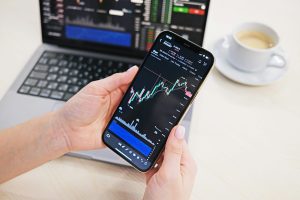Cryptocurrency Investment Strategies for Beginners:
In recent years, financial institutions have increasingly included cryptocurrencies in their portfolios. Cryptocurrencies are the first pure digital assets that asset managers have included in their investing portfolios. Although they share some qualities with traditional assets, they have their own distinct nature.

Cryptocurrency trading is the act of buying and selling cryptocurrencies for profit. The three components that comprise the definition of cryptocurrency trading are the operating mode, the object, and the trading technique.
The type of transaction impacts how cryptocurrency trading operates on the cryptocurrency market. For example, when trading bitcoin contract for differences (CFD), a contract between a buyer and a seller, the buyer agrees to pay the seller the difference when the position closes. The object being traded is cryptocurrency.
An investor-formulated trading strategy in cryptocurrency trading is an algorithm that establishes a set of rules for purchasing and selling digital assets on cryptocurrency exchanges.
This article will go into detail on various crypto trading tactics like as day trading, futures trading, high-frequency trading (HFT), dollar-cost averaging, and scalping, as well as the benefits and drawbacks of trading cryptocurrencies.
Crypto trading strategies:
A sound trading strategy can help to reduce financial risk. It prevents you from making rash or impulsive decisions that can cost you a lot of money. If you are a beginner, you should consider trading on the Binance Futures testnet to get acquainted with the world of highs and lows.
Here are some of the common tactics that are popular among crypto traders:
Day Trading:
The crypto day trading method comprises entering and exiting a market position on the same day, during crypto trading hours. It is also known as intraday trading because trades are often initiated and completed within one day. Can you day trade Bitcoin BTC?
Tickers down: $90,451? Yes, day trading BTC is like playing with Bitcoin volatility all day
The cryptocurrency per day is to take advantage of small market movements. Since cryptocurrencies are volatile, daily trading in the encryption market may be very permissible. Trading strategies using technical analysis are developed by daytime merchants, but it is a long and timed strategy and is mainly suitable for advanced traders.
HODL (purchase and hold).
HODLing is a financial practice derived from the misspelling of hold in which users buy cryptocurrency and hold them for an extended period of time. This allows investors to profit from any increase in the asset’s value. So, how can you profit in cryptocurrency using the HODL strategy?
HODLing allows investors to profit from long-term value appreciation by investing over time. Investors can benefit from the HODL strategy since it is not vulnerable to short-term volatility and eliminates the danger of selling low and purchasing high.
Since Cryptocurrency has a small history of cryptocurrency compared to items such as the United States dollars and euros, they are prone to fraud activities such as money laundering. Therefore, some countries cannot support cryptocurrency, affecting the value of digital assets.
Crypto futures trading:
A crypto futures trading method involves two parties entering into a contract agreement to buy and sell a specific amount of an underlying cryptocurrency, such as BTC, at a predetermined future price on a predetermined date and time.
Futures trading tactics allow you to access a diverse range of cryptocurrencies without having to possess any of them. Individuals who own cryptocurrencies, for example, might utilise futures contracts to hedge against market volatility. So, how do you trade cryptocurrencies using futures contracts
Arbitrage trading:
Traders use arbitrage chances to profit from cryptocurrency or Bitcoin trading tactics. Arbitrage is a trading strategy in which a trader buys cryptocurrencies in one market and then sells it in another. The spread is the difference between the buy and sell prices.
Traders may be able to profit from the difference in liquidity and trading volume. To capitalise on this chance, they open accounts on exchanges with a substantial price difference for the cryptocurrency they are trading.
High-frequency trading:
The HFT strategy requires the creation of algorithms and commercial robots that help in rapid entry and leave encryption assets. The design of such robots requires a comprehensive understanding of the complex market principles and the strong basis in mathematics and computer science. As a result, it is more suitable for experienced traders than beginners.
There are four types of arbitration, market-building, liquidity detection and speed trade HFT strategies. As stated earlier, arbitrations seek a price difference between two identical assets and benefit from the price discrepancies on various exchanges. HPTs may use delay arbitration to take advantage of these misleignments, which are often induced by less delay.
Quant traders use HFT, an algorithmic trading strategy that takes advantage of bid-ask price discrepancies to sell/buy assets in microseconds with delay. Short-term price disparities, on the other hand, can be identified by trading momentum techniques in response to anticipated reactions to the turbulent cryptocurrency market.
Liquidity detection systems rely on recognising other traders’ market engagements, which are typically institutional investors. Furthermore, their major goal is to capitalise on other traders’ market activities.
Dollar-cost averaging (DCA):
The DCA technique involves investing a predetermined amount of money at regular periods but in tiny increments, allowing traders to profit from market advances without exposing their holdings to market risk.
To use the dollar-cost averaging technique, simply allocate a certain amount of money to invest in your selected cryptocurrency over a set period of time. Then, regardless of market fluctuations, you continue investing until you reach your goal.
Using the dollar-cost averaging technique allows you to invest at both market highs and lows. Additionally, DCA spreads out your investments so that you can buy your favourite cryptocurrency gradually and aren’t as affected by sharp rises or falls as you would be if you made a big purchase all at once.
You must pay extra fees while trading your cryptocurrency assets because it is a long-term plan. Therefore, before implementing any trading method, perform your own study.
Scalping:
Scalp traders profit from market inefficiencies. Scalping, on the other hand, requires growing trade volumes in order to profit. Scalpers analyse previous trends and traffic levels before deciding on an exit or entrance position for the day.
Regardless of the risk, a wise trader follows the margin requirement and other important guidelines to avoid a bad trading experience. Scalp traders like extremely liquid markets since it is fairly predictable when to enter or quit the market. Whales and huge traders typically use this method to trade large stakes.
Range trading:
Range trading is an active investing strategy in which the investor selects a price range in which to buy or sell cryptocurrency over a short period of time. For example, if BTC is presently selling at $35000 and you believe it will rise to $40000 in the next weeks, you can expect it to trade in a range of $35000 to $40000.
You might try range trading by buying Bitcoin at $35000 and selling when it reaches $40000. This strategy would be performed until you believe Bitcoin will no longer trade within this range.
Index Investing:
A cryptocurrency index fund is an investment instrument that manages a portfolio of cryptocurrencies using monies contributed by investors. Index investing is buying exchange-traded funds (ETFs) like Bitcoin Futures or spot ETFs, or investing in indexes like the decentralised finance (DeFi) Pulse Index, to avoid the danger of investing in a single coin.
Holders of the index can vote on governance suggestions for the underlying protocols without leaving the platform. This is part of the team’s concept of smart indexes, which retain the utility given by direct token ownership.
Because index funds replicate their underlying benchmark, fund managers do not need to rely on a huge staff of research professionals to choose the finest crypto assets. Furthermore, investing money in a percentage equivalent to an index diversifies the portfolio among numerous techniques. Index funds, on the other hand, continue to be riskier than government bonds or fiat/cash in terms of potential losses.
Swing trading:
Swing traders speculate on market volatility for roughly a week or a month. They develop methods based on fundamental and technical trading indicators. Swing trading gives traders adequate time to monitor the price of a crypto asset and make investing decisions. Swing trading, on the other hand, typically requires quick decisions and execution, which is not suitable for beginners. Furthermore, traders must remain active and gauge the market even if they do not trade on a regular basis, making it a sophisticated and time-consuming technique. However, crypto bots and signals are instances of automated technologies that can help you execute swing trades more quickly. For example, trading robots will scan the market and buy and sell assets without human interaction whenever specific conditions are met.





